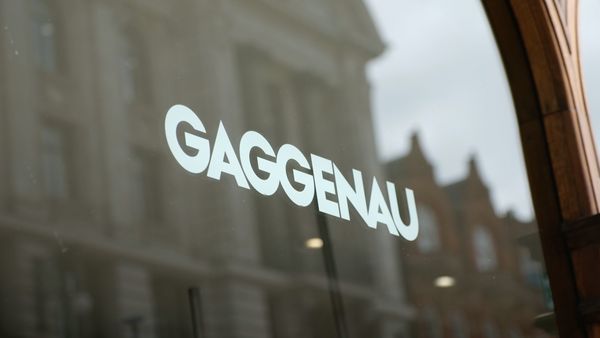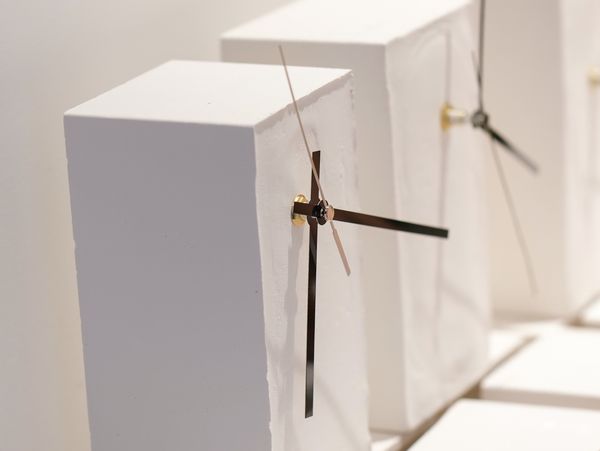
We all have a complex and important relationship to time, from our own internal clock to our shared and conscious existence on this planet. TIME is a series of functional art objects stacked vertically on display at Gaggenau London, including strategic glimpses, considering the viewers’ awareness of space and time in the showroom, in the city, or around the world. With the clocks set to global time zones and comprising of plaster, a common material used in buildings, familiarity is generated, highlighting the possibilities of architecture connecting us all.
TIME is designed by architect and stage designer Raphaé Memon and visual artist Sikander Pervez. Raphaé and Sikander are both interested in creating work that explores the object-viewer relationship, uncovers behind-the-scenes processes, and transforms objects to give them a spatial and performative capacity.
TIME will be on display at the Gaggenau London showroom from 1st to 30th June 2023 as part of London Festival of Architecture.


What is the inspiration behind the installation?
TIME is inspired by the brand’s focus on hand-craftmanship, heritage and sustainability. We explored Gaggenau’s history from the German Black Forest, famous for the Cuckoo Clocks, and the significance and grounding of this symbol as a value reflected across every aspect of the brand. A commonality found throughout is time – the time it takes to consider lifestyles around which the appliances are designed; everything is manufactured precisely to ensure minimal amount of waste is produced, so the maximum amount of time is shared between the consumers and appliances that are built to last.
Time is known to move at different speeds in different places. Theoretical physicist Carlo Rovelli talks about how if you compare two clocks, where one is high up in the mountains, and the one is lower at sea level, that the former will run faster. Time is relative and its movement varies depending on where you are and the speed at which you are moving. We found this idea interesting and decided to reflect this aesthetically through an undulating rhythm.

How does the concept of TIME relate to your practices as designers?
Creating movement through static forms is something that fascinates us. Rovelli talks about how the world is composed of events rather than ‘things’, and that time as a concept exists due to the idea of change, and movement from the past to the future. We are both interested in the idea of the ‘state of flux’ and ‘becoming’ – the processes behind creating artwork is important to us, as well as its afterlife.
Raphae: As a stage designer, I enjoy creating atmospheres that engage the senses and offer a suspension of disbelief. Each viewer brings with them their own history, experience, and view of the world, and this is not static. The energy of an audience reacting to a piece of live performance or theatre is akin to atoms and molecules generating heat and movement. This is precisely what the concept of ‘time’ entails.
Sikander: I work with time in many ways; collapsing past, present, and future into one visual event and the injection of implied movement to anthropomorphise objects that are designed for us by us. This is part of his interest in the human relationship with inanimate objects and the distance we place between us and them, even if they are a staple in our lives.

What is unique about the installation?
Each clock is handmade and signed as an edition of 200, designed for their life to continue beyond the installation. For their afterlife, the clocks will find their way to different homes through donation, extending their time as functional objects, and in-keeping with the global conversation surrounding sustainability.
Viewers are encouraged to explore the showroom to discover more about the art objects, which are conceptually bound together using Gaggenau’s signature blue pigment.


About the designers
Raphaé Memon is a British architect and award-winning designer, working on projects from the scale of civic public events and buildings to stage sets and sculpture. He studied Architecture from The Bartlett UCL and Manchester School of Architecture, and his projects explore the development of architectural space from the lens of a stage designer, and vice versa. Raphaé has designed sets for operas and fashion, worked for the London Design Festival at the V&A, and on installations for artist Es Devlin. His architectural experience includes work with Buckley Gray Yeoman, Nissen Richards Studio, BDP, Herzog & de Meuron and Arup.
Sikander Pervez is a British artist working in the medium of sculpture and installation. Sikander read Fine Art at Staffordshire University, where his interests from a young age in product design and exposure to his Father’s electrical engineering factory fuelled the exploration of the relationship between human beings and inanimate objects from the domestic realm. Sikander has showed as part of group exhibitions, won awards, was asked to participate in artists talks, and was selected for a solo exhibition at The New Art Gallery Walsall.
To learn more about the designers, and to discover the making of this installation, please visit:



